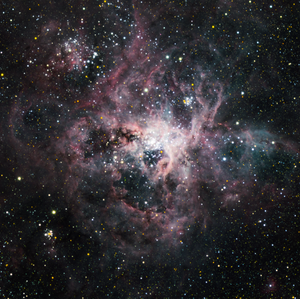
In mid-April of this year, a newly-built telescope with a mirror of diameter of 0.8 m collected its first light from the Tarantula Nebula in the Large Magellanic Cloud (see the picture). This impressive image is composed of 120 individual exposures, each 30 seconds long, in three filters corresponding to blue, green, and red colors. The image was taken with a professional Andor iKon-L 936 camera mounted on the telescope built by the Austrian company ASA. The telescope has been named Zbigniew "Zibi" Kołaczkowski and is the first of three telescopes ready for astronomical observations that were installed earlier this year at the Polish Observatory Cerro Armazones (OCA) in the Atacama Desert in northern Chile. Due to its harsh atmospheric conditions, such as dry air and extremely low rainfall, the Atacama Desert is the best place for astronomical observations in the world, providing over 330 starry nights per year. The newly-built telescopes have joined the 0.8-meter near-infrared IRIS telescope, which has been observing at OCA since 2008. In two years, the observatory will host yet another new 2.5-meter telescope, which will become the largest Polish telescope built to date. This huge scientific and technical undertaking is made possible thanks to the financial support from the Polish Ministry of Education and Science, and the European ERC Synergy scientific grant. The observatory is managed by the international collaboration, Araucaria Project, led by Prof. Grzegorz Pietrzyński of the Nicolaus Copernicus Astronomical Center of the Polish Academy of Sciences in Warsaw. The goal of the Araucaria Project is to calibrate the cosmic distance scale, and to this end, for over 20 years the team has been determining distances to galaxies in the vicinity of the Milky Way. The newly-built telescopes will observe much more distant galaxies, which will allow us to determine distances on a much larger scale, and, in the future, to refine the value of the Hubble constant.
Text:Paulina Karczmarek
picture: Mirosław Kicia






